——— O ———
OAR – Original Aspect Ratio. The aspect ratio in which a movie was originally produced. Because the aspect ratio is sometimes changed to accommodate television screens and other formats, the OAR is used to indicates the original format.
OBA – Object-Based Audio.
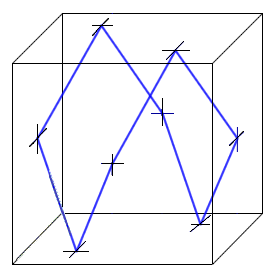
object-based audio (OBA) – a method of producing surround sound in which sounds are directed toward a particular point in space, rather than a particular speaker or set of speakers. Originally designed for video games, object-based audio is now being used for immersive sound, so that sounds are directed according to the setup of a particular theater rather than a specific setup or a set number of speakers. Sometimes called object-oriented audio.
object-oriented audio – see object-based audio.
oblique mode – one of the three room modes in which resonance in a room is caused by sound reflecting off all six surfaces (four walls, floor, and ceiling) in a room.
oboe – a musical instrument in the woodwind family with a double reed and slender conical bore tube made of wood with holes that are opened and closed with keys and a slightly flared bell. It is a little smaller than a clarinet.

OBU – Outside Broadcast Unit. A team of technicians responsible for recording or broadcasting away from a studio.
OCA – Open Control Architecture. See AES70.
OCA Alliance – a trade organization founded in 2011 to promote the standardization and adoption of Open Communications Architecture through marketing, education, and training. It also develops new OCA standards and related materials to increase the value and usability of OCA as an interoperability tool for the media systems industry. In 2016, OCA was established as a standard by the AES.
occlusion effect – the phenomenon caused by wearing solid earplugs, hearing aids, or some in-ear monitors that causes a person's voice to sound hollow, boomy, and louder to themselves, the “voice-in-a-barrel” effect. A person can experience the effect by sticking their fingers in their ears and speaking.
OCT – Optimized Cardioid Triangle.
octal tube – a vacuum tube that has an 8-pin base, developed by RCA in 1935.
octave – (1) The interval between any two frequencies when the upper frequency is twice that of the lower frequency. For example, A5 has a frequency of 880 Hz, which is twice that of A4 at 440 Hz. The octave represents eight notes on the diatonic scale (counting the first and last note on the scale). It covers twelve semitones. An octave is also the smallest interval between two notes with the same name. It is also called a perfect octave. (2) The eighth note or eighth degree of a diatonic scale, an octave above the tonic. Notes separated by an octave (or multiple octaves) have the same letter name. See also supertonic, mediant, subdominant, dominant, submediant, and leading tone.
octave band – (1) All the frequencies within an octave. For example, there is one octave between 100 Hz and 200 Hz, as well as between 5 kHz and 10 kHz. (2) In acoustics, the range of frequencies in which the upper frequency limit is twice that of the lower frequency limit. For example, the octave band with a center frequency of 1000 Hz contains all frequencies from 707 to 1414 Hz. The lower limit can be calculated by dividing the center frequency by 1.4142 (the square root of 2), while the upper limit is the center frequency times 1.4142. Sound pressure level for a given space is often measured in octave bands, and the ISO has divided the audio spectrum into 10 equal parts, defining preferred center frequencies and upper and lower frequency limits as shown in the table below for bands 1 through 10. See also one-third octave band and one-half octave band.
| Band Number | Center Frequency (Hz) |
Lower Frequency Limit (Hz) |
Upper Frequency Limit (Hz) |
|---|---|---|---|
| 16 | 11 | 22 | |
| 1 | 31.5 | 22 | 44 |
| 2 | 63 | 44 | 88 |
| 3 | 125 | 88 | 177 |
| 4 | 250 | 177 | 355 |
| 5 | 500 | 355 | 710 |
| 6 | 1000 | 710 | 1420 |
| 7 | 2000 | 1420 | 2840 |
| 8 | 4000 | 2840 | 5680 |
| 9 | 8000 | 5680 | 11360 |
| 10 | 16000 | 11360 | 22720 |
octave equalizer – an equalizer that divides the 10-octave range of the audio spectrum into a total of ten bands, with a separate fader each controlling a one-octave band. It does not allow for as precise a control over the sound as the one-half octave equalizer or the one-third octave equalizer. Also called a 10-band equalizer.
OCXO – Oven-Controlled Crystal Oscillator.
odd-order harmonic distortion – harmonic distortion created when a waveform is distorted symmetrically, such as with digital clipping. Asymmetric distortion has more even-order harmonics, which reinforce the fundamental (original note). Human ears like the sound of even-order harmonics which is why some people prefer the sound of tubes over solid state electronics. Odd-order harmonics work against the fundamental and produce sounds that are not pleasing to the ear.
OE – Operator Error.
OEO – One End Open. Grounding one end (usually the sending end) of a connecting cable.
oersted (Oe) – the unit for measuring magnetic field strength (intensity) in the CGS (centimeter-gram-second) system, equal to one dyne per unit pole. In SI units, 1 oersted equals approximately 79.5775 amperes per meter.
OFC – Oxygen-Free Copper.
OFDM – Orthogonal Frequency-Division Multiplexing. A method of encoding digital data on multiple carrier frequencies used digital communication. It is used in many applications, including wireless networks, digital television, digital audio broadcasting, and cellular phone communications.
off-axis – at some angle away from the center of a microphone. Also called off-mic.
off-axis coloration – a change in the frequency response for sounds that arrive at the front of a microphone from some angle off axis.
offline – (1) Inactive or not available for use. Opposite of online. (2) Not connected with or controlled by a computer or network. (3) Not connected to the internet.
offline editing – see video editing.
offload – to transfer the processing of a plug-in from the main microprocessor (CPU) to another microprocessor, such as a DSP accelerator. Dividing processing duties among multiple processors saves the processing power of the CPU.
off mic – see off axis.
offset – (1) A correction in time difference between two or more devices to achieve synchronization. (2) The SMPTE signal that triggers a MIDI sequencer to start. Also called offset time.
offset angle – see axis angle.
offset time – see offset.
.oga – file extension for the Ogg Vorbis format.
.ogg – file extension for the Ogg Vorbis format.
Ogg Vorbis – an open source audio compression codec and file format, similar to formats such as MP3 or AAC. Vorbis is the codec while Ogg is the container format. It uses the .ogg or .oga file extensions.
ohm (Ω) – the unit for measuring resistance, defined as the electrical resistance between two points of a conductor when a constant potential difference of 1 volt is applied to these points to produce a current of 1 ampere. Named for German physicist Georg Simon Ohm, who was known for his discoveries in mathematics, acoustics, and electricity.
Ohm's law – the principle stating that the direct current flowing in a conductor is directly proportional to the potential difference between its ends, with the proportionality constant being the resistance of the conductor. It is usually stated with the formula V = IR, where V is the potential difference (voltage), I is the current in amperes, and R is the resistance, in ohms, of the conductor.
OL – OverLoad.
old philharmonic pitch – see pitch standard.
Olson Stereo 180 microphone system – see Olson technique.
Olson technique – a stereo microphone technique proposed) by Lynn T. Olson of Audionics, Inc. in 1979. The goal of this technique is to create a 180° soundfield. It uses two hypercardiod microphones spaced 5 to 20 cm (2 to 8 in) apart and angled at 135°. It has the widest acceptance angle of any of the near-coincident methods. As a result it can suffer from indistinct sound in the middle. Also called the Olson Stereo 180 microphone system.
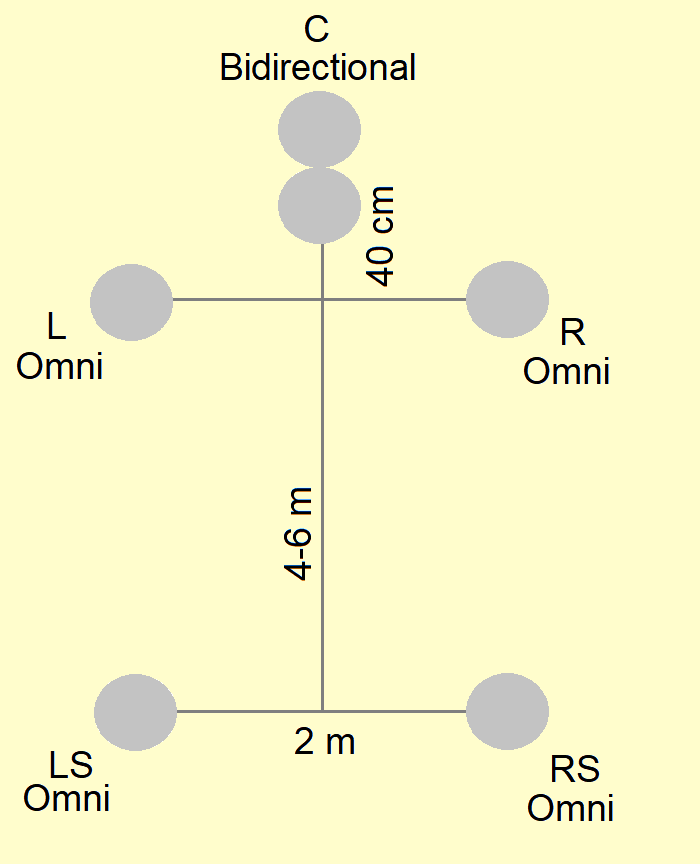
.oma – file extension for the ATRAC format.
OMF – Open Media Framework.
OMI – Open Music Initiative.
OMFI – Open Media Framework Interchange. See open media framework.
omni – short for omnidirectional. Omni- is a prefix meaning “all” used in words such as omnipotent and omnivorous.
omni+8 – a surround sound microphone technique for the front microphone array. Designed for the three front channels only, it is typically used with the omini+8 surround technique. It consists of two omnidirectional microphones spaced 2 meters (6.5 ft) apart for left and right, and a figure-eight microphone for the center placed 40 cm (16 in) forward. The omnidirection mics provide a rich and extended impression with ample bass response, while the figure-eight mic provides a strong, stabilized center channel.
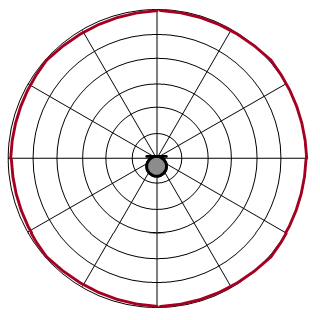
omni+8 surround – surround sound microphone technique, the surround version of omni+8. It consists of two omnidirectional microphones spaced 2 meters (6.5 ft) apart for left and right, and a figure-eight microphone for the center placed 40 cm (16 in) forward. The left and right surround mics are omnidirectional microphones placed 4 to 6 meters (13 to 20 ft) behind the front array, and 2 meters (6.5 ft) apart. If there excessive room reflections, bidirectional (figure-eight) microphones may be substituted for the surround channels.
omnidirectional microphone – a microphone with an omnidirectional pick up pattern, which has equal sensitivity in all directions.
Omnidirectional microphones of necessity must be designed to be either free-field (close to the sound source) or diffuse-field (beyond the critical distance) and should be used accordingly. Some omni microphones have interchangeable grids that allow switching from one response type to the other.
Sometimes called a non-directional microphone. Called omni for short.
omnidirectional pattern – a microphone pick up pattern with equal sensitivity in all directions. See also polar pattern.
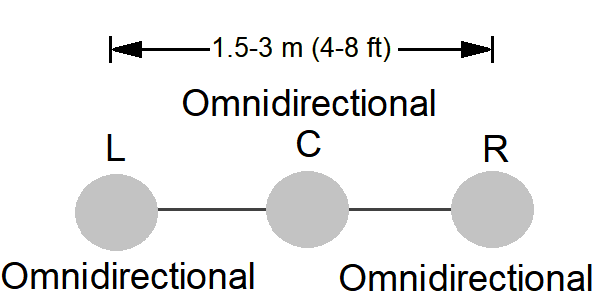
omni triad – a stereo microphone technique developed by C. Robert Fine, while working for Mercury Records and used for their Living Presence series for recording orchestral music. It consisted of an omnidirectional microphone in front of the orchestra positioned to obtain the best mono recording usually about 12 feet high. Then two additional omni mics would be added to capture the left and right sides, placed at the same height. The center mic was fed to a single-channel tape machine for the mono recording, while the signals from all three mics were sent to a separate three-track machine, which would be mixed down to 2-channel stereo. For the stereo mix, they began with the center channel and then brought up the other two channels panned left and right until the desired stereo effect was achieved. Compare with the Decca tree. Also called the Bob Fine triad, Mercury triad, or Living Presence method. See table comparing various stereo microphone techniques.
OMS – Open Music System. Apple's system for handling the exchange of MIDI data between applications that was used in OS 9. It was replaced by AMS (Audio MIDI Setup) in OS X.
on-axis – directly in front of the microphone.
on-board effects processor – an internal processor contained within a synthesizer, mixer, or other device to add effects such as reverberation and delay.
one-bit – see 1-bit and delta-sigma modulation.
one-half octave band – (1) All the frequencies within one-half of an octave. (2) In acoustics, the range of frequencies in which the lower frequency limit is 1.4142 (square root of 2) times the lower frequency limit. The lower limit can be calculated by dividing the center frequency by 1.1892 (the fourth root of 2), while the upper limit is the center frequency times 1.1892. Sound pressure level for a given space is often measured in octave bands or one-third octave band, but sometimes half-octave bands are used. The center frequencies and upper and lower frequency limits for one-half octaves are shown in the table below. See also octave band and one-third octave band.
| Band Number | Center Frequency (Hz) |
Lower Frequency Limit (Hz) |
Upper Frequency Limit (Hz) |
|---|---|---|---|
| 1 | 16 | 13 | 19 |
| 2 | 22 | 19 | 26 |
| 3 | 31.5 | 26 | 37 |
| 4 | 44 | 37 | 52 |
| 5 | 63 | 52 | 74 |
| 6 | 88 | 74 | 105 |
| 7 | 125 | 105 | 149 |
| 8 | 177 | 149 | 210 |
| 9 | 250 | 210 | 297 |
| 10 | 354 | 297 | 420 |
| 11 | 500 | 420 | 595 |
| 12 | 707 | 595 | 841 |
| 13 | 1000 | 841 | 1189 |
| 14 | 1414 | 1189 | 1682 |
| 15 | 2000 | 1682 | 2378 |
| 16 | 2828 | 2378 | 3364 |
| 17 | 4000 | 3364 | 4757 |
| 18 | 5657 | 4757 | 6727 |
| 19 | 8000 | 6727 | 9514 |
| 20 | 11314 | 9514 | 13454 |
| 21 | 16000 | 13454 | 19027 |
one-half-octave equalizer – an equalizer that divides the 10-octave range of the audio spectrum into a total of twenty bands, with a separate fader each controlling a one-half octave band. It provides a more precise control over the sound than an octave equalizer, but not as precise as the one-third octave equalizer. Also called a 20-band equalizer.
one-handed tapping – a guitar playing technique in which the strings are tapped in conjunction with the normal fingering by the fretting hand to produce note intervals that would otherwise be impossible with one hand alone. It is often used on an electric guitar with a distorted tone, such as during a shredding solo, but can also be used on an acoustic guitar. See also two-handed tapping.
one-note bass – see one-note boom.
one-note boom – the undesired increased in intensity of a particular bass frequency due to the occurrence of resonance or being located at the antinode of a standing wave. No matter what bass note is being played, it seems as if only one frequency is being heard. Also called one-note bass.
one-third octave – (1) Frequencies that are spaced every one-third of an octave apart, such as from C to E or A to C♯. One-third of an octave is 1.26-times above a starting frequency (1/3-octave = 21/3 = 1.260). Should not be confused with third octave. (2) The bandwidth of filters and equalizers that are 1/3-octave wide at the point of half-power (-3 dB). See one-third octave band.
one-third octave band – (1) All the frequencies within one-third of an octave. (2) In acoustics, the range of frequencies in which the upper frequency limit is 1.260 (cube root of 2) times the lower frequency limit. The lower limit can be calculated by dividing the center frequency by 1.1225 (the sixth root of 2), while the upper limit is the center frequency times 1.1225. Sound pressure level for a given space is often measured in octave bands or one-third octave band. The ISO and ANSI have established preferred center frequencies for one-third octaves, as shown in the table below. See also octave band and and one-half octave band.
| Band Number | Center Frequency (Hz) |
Lower Frequency Limit (Hz) |
Upper Frequency Limit (Hz) |
|---|---|---|---|
| 1 | 16 | 14 | 18 |
| 2 | 20 | 18 | 22 |
| 3 | 25 | 22 | 27 |
| 4 | 31.5 | 27 | 35 |
| 5 | 40 | 35 | 44 |
| 6 | 50 | 44 | 56 |
| 7 | 63 | 56 | 70 |
| 8 | 80 | 70 | 88 |
| 9 | 100 | 88 | 111 |
| 10 | 125 | 111 | 140 |
| 11 | 160 | 140 | 177 |
| 12 | 200 | 177 | 223 |
| 13 | 250 | 223 | 281 |
| 14 | 315 | 281 | 354 |
| 15 | 400 | 354 | 445 |
| 16 | 500 | 445 | 561 |
| 17 | 630 | 561 | 707 |
| 18 | 800 | 707 | 891 |
| 19 | 1000 | 891 | 1123 |
| 20 | 1250 | 1123 | 1414 |
| 21 | 1600 | 1414 | 1781 |
| 22 | 2000 | 1781 | 2245 |
| 23 | 2500 | 2245 | 2828 |
| 24 | 3150 | 2828 | 3564 |
| 25 | 4000 | 3564 | 4490 |
| 26 | 5000 | 4490 | 5657 |
| 27 | 6300 | 5657 | 7127 |
| 28 | 8000 | 7127 | 8980 |
| 29 | 10000 | 8980 | 11314 |
| 30 | 12500 | 11314 | 14254 |
| 31 | 16000 | 14254 | 17960 |
| 32 | 20000 | 17960 | 22627 |
one-third octave equalizer – an equalizer that divides the 10-octave range of the audio spectrum into a total of 30 or 31 bands, with a separate fader each controlling a one-third octave band. This allows for very precise control over the timbre of sound reproduction. Also called a 30-band equalizer or 31-band equalizer. See also the octave equalizer and the one-half octave equalizer.
one-to-one – see 1:1.
online – (1) Active and ready for use. Opposite of offline. (2) Connected with or controlled by a computer or network. (3) Connected to or available on the internet.
online audio production collaboration – see remote collaboration.
online distribution – see digital distribution.
online editing – see video editing.
online radio – see internet radio.
online video distributor (OVD) – an over-the-top provider defined by the FCC as “any entity that offers video content by means of the Internet or other Internet Protocol (IP)-based transmission path provided by a person or entity other than the OVD.”
on-location – filming a movie or recording a television play or program at a place away from the studio.
on-location recording – a recording made outside the recording studio, such as a live performance at a concert. Also called remote recording.
on the grid – in a digital audio workstation, having synchronization precisely aligned with bars and beats on the timeline. If a session contains both audio and MIDI tracks, both must be aligned.
opaque – a descriptive term for a sound that lacks detail and transparency. Similar to muddy.
op amp – see operational amplifier.
open-air acoustic – not having any reverberation such as when recording outdoors. In a studio open-air acoustic is simulated by using screens and other devices to surround sound sources and microphones to reduce reflections.
open-air headphones – see open-back headphones.
open back – see sealed back.
open-back cabinet – a type of speaker cabinet in which the rear of cabinet is open or partially open, which means the sound can emerge from both the front and the back. This provides a broader dispersion, but generally produces less bass. Although open-back cabinets are most commonly used for electric guitar amplifiers (combo amps), they are occasionally used for other applications.
open-back headphones – a type of circumaural headphones that has the back of the earcups open. While this configuration lets more ambient sounds into the headphone than closed-back headphones, it also leaks more sound out. However, such headphones provide a more natural and spacious sound. Also called open headphones or open-air headphones.
open circuit – a break in an electric circuit that prevents current from flowing. An open circuit can be either intentional, such as a switch, or unintentional, such as a broken wire.
Open Control Architecture (OCA) – see AES70.
open headphones – see open-back headphones.
open media framework (OMF) – a platform-independent file format developed by Avid for the transfer of digital media files between a variety of digital audio workstations, audio editors, and other media software applications. Also called open media framework interchange (OMFI). See also AAF, BXF, MXF, and XML.
Open Music Initiative (OMI) – a non-profit group of academic institutions, music and media organizations, creators, technologists, and policy experts whose mission is to promote and advance the development of open source standards and innovation related to music that help assure proper compensation for all creators, performers, and rights holders of music. Their goal is use new technologies to simplify the way music rights owners are identified and compensated so that sustainable business models for artists, entrepreneurs, and music businesses are created.
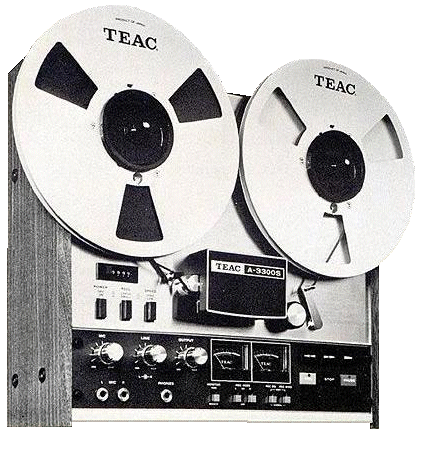
open reel – a type of tape machine in which the magnetic recording tape is held on reels—a supply reel and a take-up reel—as opposed to a machine in which the tape is housed in a plastic case, such as a cassette or cartridge. Also called reel-to-reel.
open sound control (OSC) – a method for communicating among computers, synthesizers, and other multimedia devices using networks. OSC sends control messages over a network using various data types commonly used in computers, whereas MIDI uses a cable and transmits only integers.
open tuning – a type of alternate tuning for string instruments, most commonly the guitar, in which strumming with no strings fingered or fretted creates a major or minor chord, rather than using standard tuning (EADGBE). Open tunings are quite often used when playing slide guitar, because you can you can change chords simply by placing a finger or slide across all six strings and moving to the desired fret. Two of the most popular open tunings are open G (DGDGBD) and open D (DADF♯AD).
open track – an unused track on a multitrack tape recorder available for recording.
open voicing – see spread voicing.
opera – an extended dramatic work, in which all parts are sung to instrumental accompaniment, that usually includes arias, choruses, and recitatives, and that occasionally includes ballet.
operating frequency – (1) The rate at which a computer performs its basic operations. Also called a clock rate. (2) The main frequency used by a device, such as a transmitter, wireless microphone, or oscillator to perform its designed functions.
operator error (OE) – a malfunction caused by the person operating or controlling a piece of hardware or software, such as a recording malfunction caused by the engineer rather than the equipment. Also called human error, user error, cockpit problem, cockpit trouble, or code 18 (the problem is 18 inches from the computer display).
operating level – a target audio level that allows adequate headroom, often indicated as 0 VU. Although sometimes called a standard operating level, there is no official standard. See -20 dBFS and maximum operating level.
operating system (OS) – the software that manages and controls computer hardware functions, such as input and output and memory allocation, and that provides common services for computer programs, acting as an intermediary between the programs and the computer hardware. Application programs usually require a specific operating system in order to function. Examples of operating systems include Microsoft Windows, Apple OS X, Android, iOS, Linux, and UNIX.
See also platform.
operational amplifier – a circuit to amplify voltages often found in audio devices. The name comes from the fact that they were originally developed to carry out mathematical operations in analog computers. Today they are largely available as integrated circuits. Called op amp or opamp for short.
OPT – Open Plug-In Technology. A MIDI application plug-in format created by Yamaha. It is used in Sony ACID PRO 4, Yamaha SOL 2, and SONAR.
optical – (1) Pertaining to sight, especially as related to light. (2) Operating in or employing the visible part of the electromagnetic spectrum. (3) A method of transferring digital data using light pulses over optical cables. See also ADAT.
optical audio cable – a fiber optic cable used in consumer audio equipment to carry a digital audio signal from components such as CD players, DVD players, computers, and other device to an AV receiver where it is decoded into two channels of uncompressed lossless PCM audio or compressed surround sound. See also TOSLINK.
optical cable – see optical audio cable.
optical compressor – a type of audio compressor that uses a light source (usually an LED or electroluminescent panel) and a photoresistor to create changes in signal gain. Optical compressors tends to produce a smoother sound than other compressor designs because the response times of the light and the resistor soften the attack and release. Unlike other types of compressor, optical compressors have fixed compression ratios, typically 3:1. An example of an optical compressor is the Teletronix LA-2A. They are well-suited for transparent compression, adding warmth and sheen, and smoothing vocals. They are not as good at controlling transients or producing aggressive compression. Also called an opto-compressor. See also tube compressor, VCA compressor, FET compressor, variable-mu compressor, PWM compressor, digital compressor, low-level compressor, and multiband compressor.
optical disc (OD) – a medium for storing digital data consisting of a metal surface coated by plastic, with the data encoded in a spiraling pattern of pits and spaces in the metal surface that can be read by a laser. Some examples are compact disc (CD), DVD, and Blu-ray disc (BD). Also called optical media.
optical disc recording modes – there are 3 main methods of recording recordable optical discs, such as CD-Rs or CD-RWs: disc-at-once (DAO), track-at-once (TAO), and session-at-once (SAO). DAO records the disc contents in one pass. In the TAO mode, the recording stops after each track, writing blocks and links to indicate the starting point for the next track. TAO discs can contain both data and audio on the same disc. SAO recording allows two or more sessions to be recorded and finalized on a single disc. Such sessions can be read from a hard disc by a computer, but more than one session usually is not readable by CD audio players.
optical effects – see opticals.
optical fiber – a thin glass fiber through which light can be transmitted. Used with fiber optics.
optical fiber cable – see optical audio cable.
optical isolator – see opto-isolator.
optical media – devices that store content in a digital form that is written and read by a laser, such as the CD, DVD, or Blu-ray disc. Optical media can store larger amounts of data and have greater long-term stability than magnetic media. Also called optical discs.
optical printer – a device consisting of one or more movie projectors attached to a movie camera, that provides the ability to re-photograph portions of film to create special effects and/or to copy and restore old films.
optical printing – printing film one frame at a time. This method of making a copy of a film allows for many more possibilities than that of contact printing.
optical recording – see optical soundtrack.
opticals – (1) Effects on 35-mm film that are made in an optical printer, such as dissolves, fades, super-impositions, freeze-frames, etc. (2) Loosely, any effect used in a film or video production. Sometimes called optical effects.
optical sensor – see photosensor.

optical sound – the type of sound reproduction on film that employs a photographic printing process of the optical track, as opposed to a magnetic stripe on the film.
optical soundtrack – the soundtrack on movie film in which a strip along the edge of the film containing audio waveforms that is photographically printed on the film through which light is shined and is converted to audible sound, a method called variable area. This was the primary means of providing sound on film until the advent of digital sound. Also called optical recording or optical track for short.
optical S/PDIF – see TOSlink or AES3.
optical spectrum – see visible light.
optical track – short for optical soundtrack.

optical tremolo – a method often used in guitar amps to create tremolo. It features a circuit that uses a opto-isolator (optocoupler) to modulate the amplitude of the signal within the preamp stage of the amplifier. Such circuits often produce a lopsided wave, rather than a steady sine wave, which is quite pleasing on the ear. It is one of the distinctive characteristics of this type of tremolo. Also called optocoupled tremolo or photocell tremolo or opto for short.
optimized cardioid triangle (OCT) – a surround sound microphone technique developed by Günther Theile and Helmut Wittek for the front microphone array. Designed for the three front channels only, it should be used with an additional configuration for the surround channel array. It uses three microphones in a triangle with the center cardioid mic facing forward about 8 cm (3 inches) in front of the two higher side supercardioid mics that face outward about 40 to 100 cm (about 15 to 40 in) from each other, resulting in recording angles from 160° to 90°. It is basically a modified Decca tree and produces high separation between left-center and right-center and good localization. It is designed to be used with an ambience array such as the Hamasaki square, the IRT cross, or a cardioid pair as used in the optimized cardioid triangle surround technique shown below.
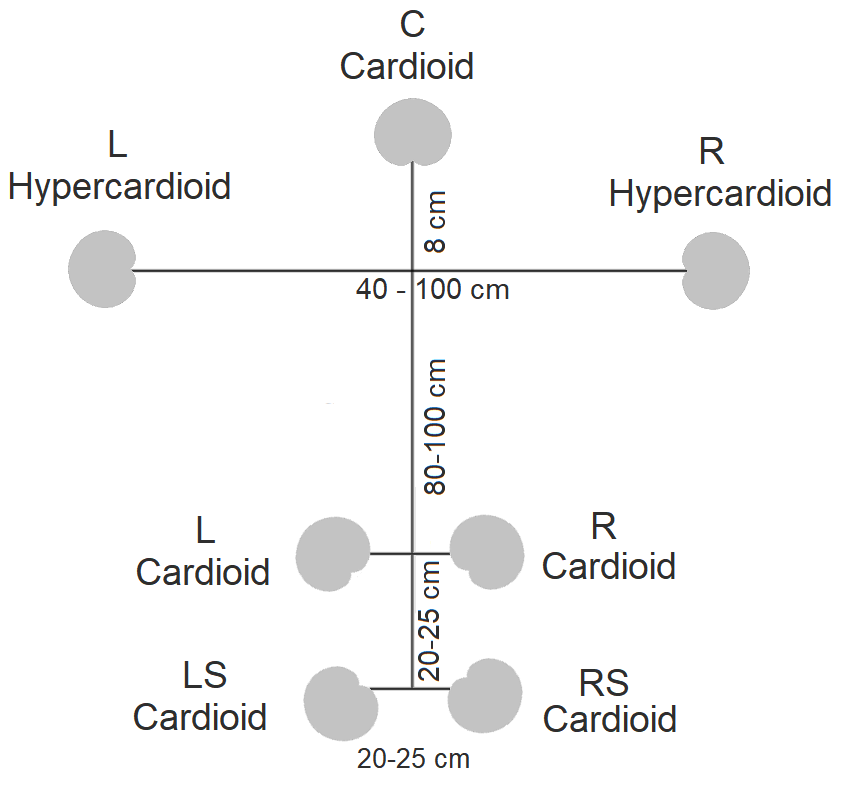
optimized cardioid triangle and Hamasaki square (OCT-Hamasaki) – a surround sound microphone technique that combines the optimized cardioid triangle (OCT) technique for the front array with a Hamasaki square for the ambience channels. The OCT uses three microphones in a triangle with a center cardioid mic facing forward and two side supercardioid mics facing outward, basically a modified Decca tree. The Hamasaki square uses four bidirectional (figure-eight) microphones arranged in a square, each facing outward with the microphone nulls pointing forward.
optimized cardioid triangle and IRT square (OCT-IRT) – a surround sound microphone technique that combines the optimized cardioid triangle (OCT) technique for the front array with an IRT cross for the ambience channels. The OCT uses three microphones in a triangle with a center cardioid mic facing forward and two side supercardioid mics facing outward, basically a modified Decca tree. The IRT cross consists of four cardioid microphones placed in a square formation, angled at 90° from one another and 45° off axis from the sound source.
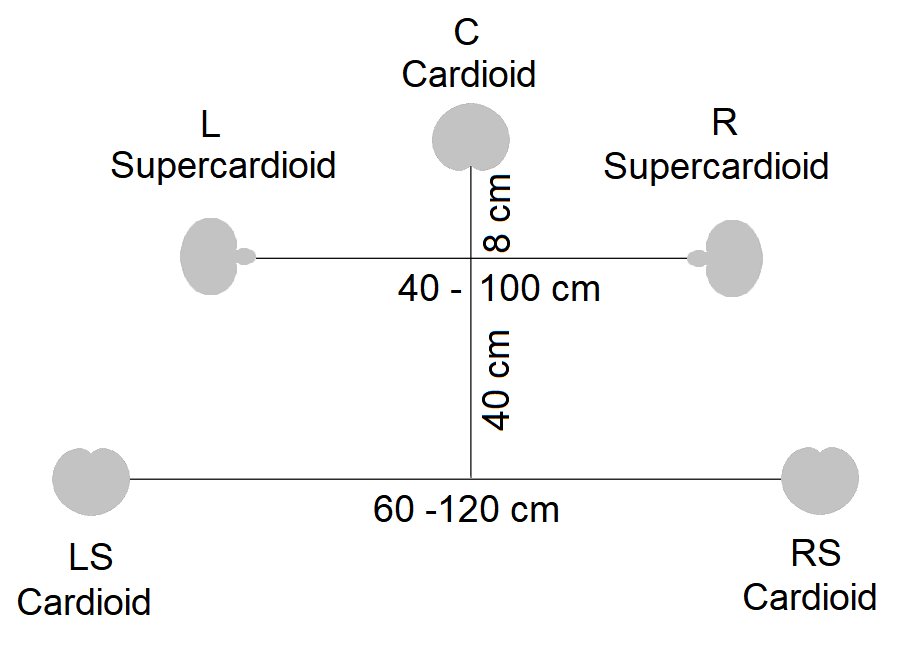
optimized cardioid triangle surround (OCT surround) – a surround sound microphone technique developed by Dr. Günther Theile that uses the OCT technique for the front array plus added surround channel microphones. The front array is designed to minimize crosstalk, by using supercardioids for the front left and right microphones spaced 40 to 100 cm (15 to 40 in) apart, angled at 90 degrees from the center cardioid microphone, which is placed about 8 cm (3 inches) forward. Two additional rear cardioid mics are placed about 40 cm (15 inches) behind the front line and an additional 20 cm (8 inches) farther out, pointing toward the rear. It produces good separation in the front, good localization, and a large listening area with a natural-sounding effect.
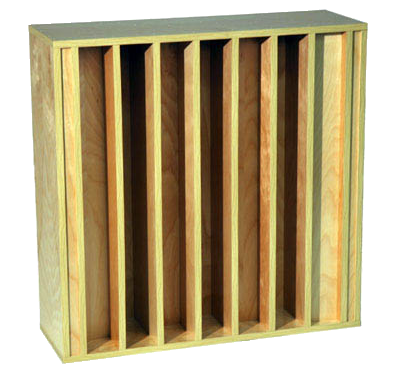
optimized diffuser –
a modified version of a quadratic-residue diffuser (QRD). A conventional quadratic residue diffuser uses the phenomenon of diffraction from a periodic reflection phase grating. To cover wide areas, the QRD is repeated, but the repetition decreases uniform diffusion. To solve this problem, RPG Diffusor Systems designed and patented a new modulated optimized diffuser (called a Modffusor™) in 1983. The optimized diffuser has an asymmetric, diffusively optimized surface, that is not restricted to the constraints of number theory, but instead uses binary Code Division Multiple Access (CDMA) modulation techniques (the same CDMA system as used in mobile telephones). Using aperiodic modulation, the performance of the single optimal base shape can be preserved, while covering an infinite area. The optimized diffuser has the appearance of pseudo-periodicity and pseudo-symmetry, which is aesthetically pleasing.
opto – short for opto-isolator or optical tremolo.
opto-compressor – see optical compressor.
optocoupled tremolo – see optical tremolo.
optocoupler – see opto-isolator.
optoelectronics – the study or use of devices in which an optical input produces an electrical output, or in which electrical stimulation produces a visible or infrared output. It should not be confused with electro-optics.
opto-isolator – an electrical component that uses light to transfer signals between two isolated points, consisting of a light source, usually an LED, and a photo detector in an optically sealed container. They are used to prevent high voltage transients and to avoid ground loops. Also called an optocoupler, photocoupler, or optical isolator.
Opus – a lossy audio coding format developed by the Internet Engineering Task Force (IETF) designed for interactive real-time applications over the internet. It is an open format that uses an audio codec called opus-tools. Use of Opus is under a royalty-free license.
Oracle Corporation – a multinational computer technology corporation founded in 1977 and headquartered in Redwood City, California. The develops and markets computer hardware and software, specializing in database management systems.
Orange Book – the informal name for the standard for the recordable compact disc (CD) developed by Philips and Sony and published in 1990, the a follow-up to the Red Book. The Orange Book is divided into two sections: Part I covers magneto-optical (MO) drives, and Part II covers the CD-R. Part III, released separately, deals with the CD-RW. See also Blue Book, Red Book, Yellow Book, White Book, and Green Book.
orange noise – an unofficial term for random noise in which the in-tune notes of a scale are removed, leaving only the out-of-tune frequencies, creating a clashing, displeasing sound. See noise colors.
orbital frequency – see angular frequency.
orchestra – a large ensemble of instruments with sections of strings, brass, woodwinds, and percussion instruments, typically having 60 to 100 musicians. A smaller-sized orchestra with fifty musicians or less is called a chamber orchestra. A full-size orchestra is sometimes called a symphony orchestra or philharmonic orchestra. These names do not indicate any difference in the purpose or constituency of the orchestra, but they are sometimes used to distinguish between two orchestral organizations located in the same city, such as the New York Philharmonica Orchestra or the New York Symphony Orchestra.
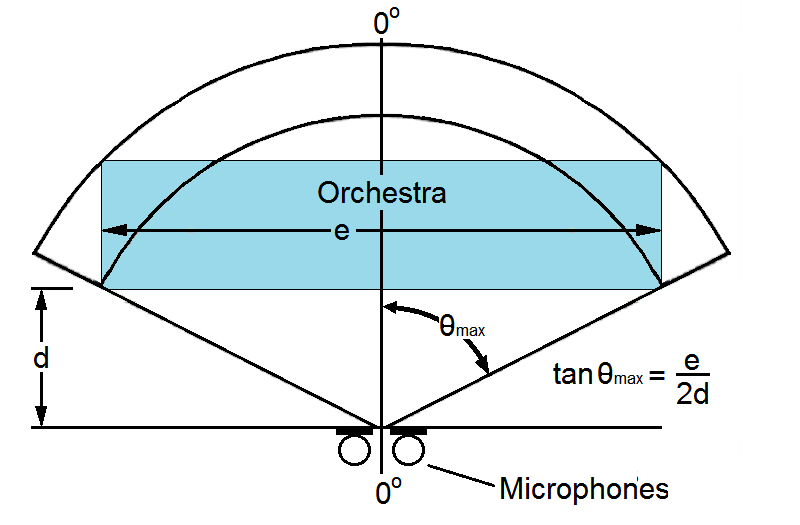
orchestra angle – the total angle from the microphones in a stereo microphone setup to the corners of the orchestra or ensemble. It depends on the width of the ensemble and the distance from the orchestra to the microphones. Also called the extension angle of the orchestra. It should not be confused with the stereo recording angle (SRA).
orchestration – the art of composing, arranging, or scoring a musical composition for performance by an orchestra or a group of instruments. Also known as instrumentation.
order – see slope, definition #3.
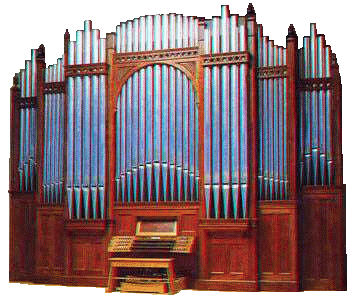
organ – a large musical instrument that makes sound by passing pressurized air through rows of tuned pipes and played by using one or more keyboards (called manuals) to produce a wide range of musical tones and effects. The pipes are grouped in sets called ranks with each rank having a common timbre and volume that the player can choose individually or in combinations through the use of controls called stops. Because pipe organs are very large and expensive, alternatives have been developed over the years. One option was replacing the pipes with reeds to create the reed organ, sometimes called a pump organ or harmonium. Later electronic organs were developed that used various electronic means to emulate pipe organ sounds, which were reproduced using a loudspeaker. Eventually, the electronic organ was combined with the synthesizer to create a electronic keyboard. Today a keyboard player can make the instrument sound like a piano, an organ, chimes, and many other sounds.
organist – a musician who plays a organ, especially one who performs expertly or professionally. See also keyboardist.
O-ring – see zero ring.
ORTF – Office de Radiodiffusion-Television Francaise. (1) The French national broadcasting system. (2) A standard established by ORTF for a stereo microphone technique that specifies two cardioid microphones spaced 17 cm (6.7 inches) apart and at an angle of 110 degrees. The ORTF technique produces recordings with a more open and spacious sound than those produced by the X-Y miking technique. ORTF works well when played back with headphone, but tends to have a somewhat dry sound lacking in warmth because it picks up minimal room ambience. However, it provides good mono compatibility, which is desired by the broadcasting industry. It falls into the near-coincident pair category of techniques. Other techniques in this category include A-B, DIN, EBS, Faulkner array, NOS, RAI. See also coincident pair (Blumlein array, mid-side, X-Y pair) and spaced pair (A-B, Decca tree, spaced cardioids, spaced omnis). See table comparing various stereo microphone techniques.
ORTF technique – see ORTF, definition #2.
orthagonal speaker layout – see Dolby Atmos speaker layout.
orthodynamic headphones – see planar magnetic headphones.
OSC – (1) Open Sound Control. (2) Abbreviation for oscillator.
oscillation – (1) Movement back and forth at regular intervals. (2) Regular variation in amplitude, current, position, or other variable around a central point, such as produced by an oscillator.
oscillator – (1) A device or circuit a circuit that produces a regular alternating output of current, voltage, or sound at a specific frequency as determined by the characteristics of the circuit components. (2) A tone generator.
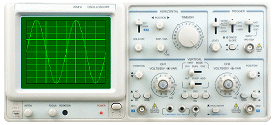
oscilloscope – an electronic instrument that displays an instantaneous trace of a waveform on a CRT screen.
OSS – Optimum Stereo Signal. See Jecklin disk technique.
ostinato – a melody or rhythm that is repeated by the same voice or instrument during a musical composition.
OS X – version 10 of the Apple operating system for Macintosh computers. It was the first complete revision of the operating system since OS 9.
OTA – Over-The-Air. See over-the-air television.
OTB – Out-of-The-Box.
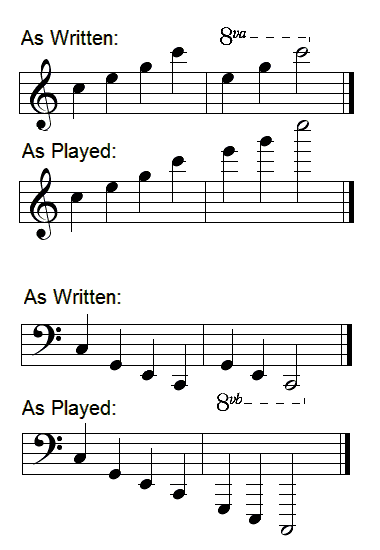
All' ottava bassa (bottom)
OTL – Output TransformerLess. A type of output (from a microphone or amplifier) using a solid-state circuit that requires no transformer. Historically, vacuum tube power amplifiers had output transformers to isolate the high output impedance of the tubes and the low impedance of the speaker load.
OTT – Over-The-Top.
ottava – musical notation indicating that a section of music is to be played an octave higher or lower than written. All' ottava alta (alternatively ottava sopra) means to transpose music up one octave, abbreviated as 8va. All' ottava bassa (alternatively ottava sotta) means to transpose music down one octave, abbreviated as 8vb. The abbreviation is shown above or below the staff with a dotted or dashed line ending with a vertical that indicates the notes to which it applies. Other abbreviations include 8a, 8a alta, and 8va bassa.
ottava bassa – see ottava.
ottava sopra – see ottava.
outboard equipment – signal processors and other audio equipment that is external to the console or digital audio workstation.
outlet – a jack or receptacle into which a plug or other input device can be inserted. See male connector and female connector.
out-of-band ripple – see ripple.
out of phase – the condition when one wave is a portion of cycle offset from another wave of the same frequency. See phase and in phase.
out of sync – two devices or music tracks that are not exactly aligned in time with one another. Opposite of in sync. See synchronize.
out-of-the-box (OTB) – a slang term referring to audio production in which all mixing and effects processing takes place primarily with hardware and equipment outside of the computer. Opposite of in-the-box.
out of tune – not being tuned to the same reference pitch, or all instruments in a group not being tuned alike. Opposite of in tune.
output – (1) The connector from which a device sends a signal or feeds another device. (2) The signal that a device sends out. (3) The amount of current, voltage, or power that a device delivers, such as 100-watt output of a power amplifier or a 12-volt power supply.
output current – the current at the output of a device, such as an amplifier, usually measured in amperes or milliamperes.
output impedance – the opposition to current flow at the output of a circuit. See also impedance matching.
output level – the signal intensity at the output of a device.
output power – see power output.
output voltage – the the potential difference at the output of a device, such as an amplifier, usually measured in volts.
outro – the ending of a song, which can either be a fadeout or a hard ending. The term is derived from intro, short for introduction. See also vamp.
outside picking – a guitar playing technique in which the bottom two strings are picked with downstrokes and the upper strings are picked with upstrokes, so that the pick ends up outside the picked strings. See also inside picking.
out-take – a portion of a work (such a recording or film) that has been edited out and not used.
OVD – Online Video Distributor.
oven-controlled crystal oscillator (OCXO) – an oscillator operated inside a temperature-controlled space that maintains the crystal and the oscillator circuit at a constant temperature in order to increase stability and avoid drift due to temperature changes.
over – the condition in which the voltage of a signal presented to an A/D converter exceeds 0 dbFS. An over is an indication of digital clipping. While a brief excursions beyond 0 dBFS cannot be heard, there is no agreement as to how far above 0 dbFS and for how long an excursion must be before an over is audible.
overdrive – (1) An effect, often used with guitars, that is a type of distortion achieved by saturating (overdriving) the vacuum tubes in an amplifier (or a simulation of this effect). (2) See overload.
overdub – (1) To record a new track in synchronization with previously recorded tracks. (2) To mix a previously recorded track with new material while recording it onto a new track. Also called sound-on-sound. (3) A track recorded using such a technique. See also live recording, all-at-once recording, and hybrid recording.
overhang – the continuation of a signal output after its input has stopped. Sometimes called ringing.
overhead microphones – (1) One or two microphones placed over a source, especially over a drum kit. A properly placed pair of spaced overheads should be able to capture the entire drum kit, but are often supplemented with spot microphones on the kick, snare, toms, cymbals, and/or hi-hat. (2) Microphones hung from the ceiling, such as for miking choirs or theater stages. Called overheads for short.
overheads – see overhead microphones.
overload – (1) To exceed the maximum input level of a system causing distortion (analog) or clipping (digital). (2) To drive a signal into distortion, an effect sometimes used with electric guitars and other instruments. Also called overdrive.
overmodulation – exceeding the maximum amplitude limit of a recording or broadcast signal, resulting in distortion.
oversampling – using a higher sample rate than normal in order to improver the accuracy of the signal. Oversampling can be done both during analog-to-digital and digital-to-analog conversion. Sometimes spelled over-sampling.
oversampling peak program meter – see peak program meter.
over-the-air television (OTA TV) – television broadcast by local stations using radio waves that are received in the home using an antenna. Most of these stations are normally included in cable and satellite television packages.
over-the-top (OTT) – a method of delivering film and television content using the internet, without requiring users to subscribe to a traditional pay-TV services such as cable or satellite television companies. OTT content is provided by such services as Netflix and Hulu. See also online video distributor (OVD).
overtone – any of a series of musical tones whose frequencies may or may not be integral multiples of the fundamental frequency, but usually are. A harmonic is always an exact multiple. However, they are numbered differently with the fundamental being the first harmonic, but the first overtone is equivalent to the second harmonic. See also partial.
oxide build-up – the accumulation of deposits of magnetic coating on the surface of the tape heads of a tape machine. Such build-up causes a loss of signal output, especially at shorter wavelengths, and increases tape wear.
oxide coating – see magnetic coating.
oxide shedding – see shedding.
oxygen-free copper (OFC) – copper that has been electrolytically refined to reduces the level of oxygen it contains. While oxygen-free copper improves electrical conductivity, the amount of improvement is insignificant in audio applications.
Note: We believe this is the largest dictionary (glossary) of terms specific to usage within the recording industry that is currently available on the internet, with more than 8,800 entries, nearly 800 illustrations, and dozens of tables. Some of the terms have different or additional meanings in other situations, especially within the electronic, automotive, scientific, and computer industries. Of necessity there are obvious overlaps into other fields such as music, electronics, and computers, but such excursions are limited to information deemed pertinent to the knowledge required to operate and/or participate effectively in the workings of a recording studio. Also included are terms related to sound reinforcement (live performances) including wireless microphone technology because a working knowledge of that terminology is necessary for recording at live performance venues. Because recording studios also record audio for video and motion pictures (films), some terminology from those fields is included. Some scientific terms are included because they help explain studio terminology. For example, electromagnetism explains how microphones, loudspeakers, and guitar pickups work. Knowledge of radio waves and the radio frequency spectrum is needed to explain wireless devices. Any trademarks or trade names mentioned belong to their respective owners. The information contained in this dictionary is believed to be accurate at the time of publication. This information is subject to change without notice. The information was obtained from and cross-checked with a variety of sources that are believed to be reliable. However, Los Senderos Studio, LLC does not guarantee the accuracy or completeness of the information contained herein. Please contact us to report any errors, omissions, discrepancies, or broken links. Los Senderos Studio shall not be responsible for any consequences or damages arising out of the use of this information. Nothing in this glossary should be interpreted as legal advice. For a glossary providing information on legal and business matters for musicians, we suggest you consult Musicians Business Dictionary.
A note on alphabetical order: The terms in this glossary are alphabetical without regard to spaces and punctuation. For example, AM Radio follows amplitude. While this may seem to be at odds with other conventions, it eliminates confusion with words such as pickup, which is sometimes written as pick up or pick-up. In addition, all symbols such as &, -, or / are ignored. The entries on the number page (0-9) are listed in increasing value within each digit. For example, all of the entries beginning with 1 are listed before those starting with 2. For Greek letters (α-ω), the entries are in Greek alphabetical order.


